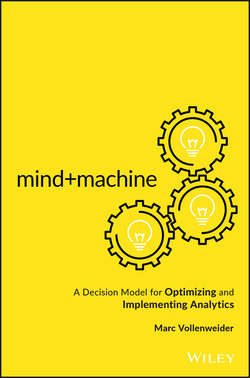Читать книгу Mind+Machine - Vollenweider Marc - Страница 6
На сайте Литреса книга снята с продажи.
PART I
THE TOP 12 FALLACIES ABOUT MIND+MACHINE
ОглавлениеThe number of incredible opportunities with great potential for mind+ machine is large and growing. Many companies have already begun successfully leveraging this potential, building whole digital business models around smart minds and effective machines. Despite the potential for remarkable return on investment (ROI), there are pitfalls – particularly if you fall into the trap of believing some of the common wisdoms in analytics, which are exposed as fallacies on closer examination.
Some vendors might not agree with the view that current approaches have serious limitations, but the world of analytics is showing some clear and undisputable symptoms that all is not well. To ensure you can approach mind+machine successfully, I want to arm you with insights into the traps and falsehoods you will very likely encounter.
First, let's make sure we all know what successful analytics means: the delivery of the right insight to the right decision makers at the right time and in the right format. Anything else means a lessened impact – which is an unsatisfactory experience for all involved.
The simplest analogy is to food service. Success in a restaurant means the food is tasty, presented appropriately, and delivered to the table on time. It's not enough to have a great chef if the food doesn't reach the table promptly. And the most efficient service won't save the business if the food is poor quality or served with the wrong utensils.
The impact on a business from analytics should be clear and strong. However, many organizations struggle, spending millions or even tens of millions on their analytics infrastructure but failing to receive the high-quality insights when they are needed in a usable form – and thus failing to get the right return on their investments. Why is that?
Analytics serves the fundamental desire to support decisions with facts and data. In the minds of many managers, it's a case of the more, the better. And there is certainly no issue with finding data! The rapid expansion in the availability of relatively inexpensive computing power and storage has been matched by the unprecedented proliferation of information sources. There is a temptation to see more data combined with more computing power as the sole solution to all analytics problems. But the human element cannot be underestimated.
I vividly remember my first year at McKinsey Zurich. It was 1990, and one of my first projects was a strategy study in the weaving machines market. I was really lucky, discovering around 40 useful data points and some good qualitative descriptions in the 160-page analyst report procured by our very competent library team. We also conducted 15 qualitative interviews and found another useful source.
By today's standards, the report provided a combined study-relevant data volume of 2 to 3 kilobytes. We used this information to create a small but robust model in Lotus 1-2-3 on a standard laptop. Those insights proved accurate: in 2000, I came across the market estimates again and found that we had been only about 5 % off.
Granted, this may have been luck, but my point is that deriving valuable insight – finding the “so what?” – required thought, not just the mass of data and raw computing power that many see as the right way to do analytics. Fallacies like this and the ones I outline in this part of the book are holding analytics back from achieving its full potential.
